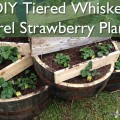
To bee or not to bee? If it were up to me, every garden and gardener would decide to become bee-friendly. Bees – particularly native ones – are critically important to the health of your garden. They’re pollinators, and you need them to create all of the lovely fruits and many of the vegetables that you eat. While some plants can self pollinate using the wind to spread their pollen around, others are highly specialized to work with specific pollinators to create their fruit. Tomatoes are a case in point: the lovely, juicy, summer tomato is good friends with the buzzing bumblebee, who buzzes with a specific tone to help the tomato release its pollen.
1. Be a Messy Gardener
Growing for the bees means becoming a messy gardener. Bumblebees like to nest in the ground, while solitary bees often nest in the old sticks and stems that you have hanging around the garden. Many important nectar and pollen plants for bees are the plants that you might consider to be weeds: dandelions are great nectar sources. Give the bees a little bit of gourmet cooking, and they’ll come to visit your garden plants as well.
2. Think of the Bees’ Year
The more garden plants, the merrier it is for the bees, especially if these plants are non-hybridized varieties. Growing a wide diversity of plants gives bees a choice of nectar and pollen sources throughout the season means that the bees will have a constant array of food to eat. If you only grow flowers that bloom in June and there’s nothing for the bees to eat in April, they won’t be nearly as happy.
3. Go Spray Free
Interestingly enough, in the area where I am, bees are on the upswing. While it’s an urban area that’s not very friendly to bees in many ways, there’s one thing that we do that’s quite bee-friendly: there has been a ban on pesticides in our area for several years now. The sprays that you use for pests can also harm bees, and being bee-friendly means thinking of other ways to control unwanted bugs. My choice? I have a lot of diversity in my garden so that if the bugs target one crop, I still have many more to choose from. I also plant trap crops like fava beans so that the aphids can have a field day with those and will leave my other crops alone.
4. Create a Good Menu
Bees need pollen for protein and nectar for carbohydrates. Do you know what plants bees prefer? Here in the Pacific Northwest, early spring plants for bees include Oregon Grape and maple flowers. Surprised? Those pretty flowers in your garden may not be what the bees are looking for. Grow a bee-friendly garden by choosing some plants that support bees.
Is your head buzzing with bee-friendly ideas yet? Head on out into the garden and create some bee habitat, or just sit back and enjoy the fact that you don’t need to weed those dandelions. It isn’t hard to become a bee-friendly gardener.










